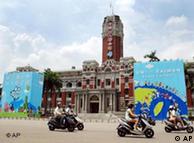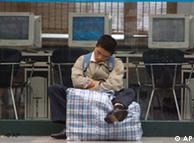Business in South-East Asia
The tigers that lost their roar
Feb 28th 2008 | BANGKOK AND KUALA LUMPUR
From The Economist print edition
Other emerging economies are producing world-class companies by the dozen. Why aren't the countries of South-East Asia?

IT IS easy to forget, now that China and India are all the rage, that until ten years ago South-East Asia was the world's fastest-developing region, winning the sort of investor attention and breathless column inches that the two new giants now enjoy. The region has, slowly, recovered from the blight of 1997-98. It has recently had several years of strong growth (see chart 1) and its governments' finances have been greatly improved. Even so, after all this time the region's five main economies—Indonesia, Malaysia, the Philippines, Singapore and Thailand—are still notable for the near-absence of companies that could truly be called world-class.

The region has 570m people and had a head start in economic development over much of the rest of Asia. So why does it still have no global consumer brands of the stature of South Korea's Samsung and LG? Where are its rising technology leaders, like Taiwan's AU Optronics and Taiwan Semiconductor? Where are its equivalents of India's world-conquering Tata Steel, Ranbaxy and Wipro? Or China's market-devouring Huawei and Lenovo? Ask an investor in London or New York to name globally respected South-East Asian firms and the answer is unlikely to consist of much more than Singapore Airlines.
In a recent book, “Asian Godfathers”, Joe Studwell, a journalist, examines this failure in stark terms. The region's business scene, he says, remains dominated by old-fashioned, mediocre, sprawling conglomerates, run at the whims of ageing patriarchal owners. These firms' core competence, such as it is, is exploiting their cosy connections with governing elites. Their profits come from rent-seeking: being handed generous state contracts and concessions, or using their sway with officialdom to keep potential competitors out. If they need technology, they buy it from abroad. As a result, Mr Studwell says, the region has “no indigenous, large-scale companies producing world-class products and services.”

Similar things were once said of much of the rest of Asia—and sometimes still are. But somehow other countries' top businesses, even in India, the home of the licence Raj, have escaped this mediocrity trap. Whereas the export-led growth of South Korea and Taiwan comes mainly from indigenous firms making globally competitive goods with their own technology, much of South-East Asia's high-value exports are made by foreign companies. Thailand has built a successful motor industry by attracting multinationals. But it will constantly suffer the risk that these will move to somewhere like China, with lower costs and a bigger home market.
Look under the bonnet of what seems to be a well managed, local industrial firm in South-East Asia, such as Astra, an Indonesian carmaker, and you find that it is assembling Japanese cars under licence and is controlled by a Hong Kong group. Not many have got far beyond serving the home market. A recent study by the Boston Consulting Group (BCG) of the 100 largest multinationals from emerging economies (a category that excludes Singapore) contained only five from the whole region. By contrast there were 13 just from Brazil, which has only a third of South-East Asia's population and which until about a decade ago had no genuinely global firms to speak of (see chart 2).
Class distinctions
To be counted as world-class, a firm needs to be more than just well run and large. It should have a globally valued brand, or its own leading-edge technology, or a genuinely innovative and admired business method. These are demanding standards: even some of those in BCG's top 100 are really just plain big. In South-East Asia few companies meet them. Some come close, especially in Singapore, the region's most advanced country. Singapore Airlines is the world's fourth-largest international carrier and is perhaps the region's best-known brand around the world. Keppel and SembCorp, the world's two largest makers of offshore oil drilling-rigs, dominate their industry.
However, some of Singapore's tech stars are showing signs of fading, worries Garry Evans, an equity strategist at HSBC. Chartered Semiconductor and Creative, for example, are slipping behind rivals in places like Taiwan, which now has “a critical mass in technology and a very entrepreneurial culture,” he says.
In banking, the region has some impressive contenders, like Singapore's OCBC and Malaysia's Public Bank, which are expanding beyond their borders. But now these must contend with China's huge and increasingly muscle-flexing banks as well as Western ones with deep roots in the region, such as HSBC and Standard Chartered. As in other types of business, the region's local champions lack scale in a world where critical mass seems to matter ever more.
Admittedly, the region has some natural handicaps. The ten members of the Association of South-East Asian Nations (ASEAN) have a huge variety of languages, religions, political systems and histories. Even the most populous member, Indonesia, with 230m people, is itself enormously diverse, being made up of 17,000 islands and a rainbow assortment of cultural and religious traditions. By comparison, Brazilians may dance the forró in the north and the samba in the south, but theirs is a pretty homogeneous and monolingual country of 190m, all on one land mass.
That said, ASEAN's leaders could do much more to keep their lofty promises of European-style economic integration, to give local companies a sizeable home market from which to build world-beating businesses. Their failure to construct a genuine single market is shown up by the fact that ASEAN's members still do three times as much trade with non-members as they do among themselves. Internal tariffs have been cut, but as McKinsey, a management consultancy, noted in a report in 2004, product standards and other non-tariff barriers often differ among ASEAN countries, forcing manufacturers to make small production runs for each country.
All this lowers the competitiveness of local firms, as well as multinational companies operating in the region. Corruption is another great burden on business. That is true elsewhere in Asia too, but several South-East Asian countries—notably Indonesia—are afflicted by corrupt and unreliable judicial systems, making it difficult to enforce contracts.
Dicing with relegation
Although it is hard to generalise across Asia, another obstacle to developing world-class businesses is that the five main South-East Asian economies do worse than might be expected—that is, relative to their national incomes—in promoting technology and higher education. Tony Fernandes, the boss of AirAsia, a fast-expanding Malaysian airline and a contender for the “world-class” label, laments how South Korea, where the government has pumped money into research and training, has left his country trailing in so many ways. “We used to beat them at football—not now,” he groans.
Malaysia has also spent heavily on universities and the promotion of technology but its efforts have been stymied by the country's messy racial politics (including preferential university places for the Malay majority) and by the handing of state contracts and concessions to undeserving government cronies. Both the lack of fair competition between businesses and the failure to widen access to education may have a common underlying cause: that South-East Asian countries remain in the grip of narrow elites.
The problem betrays itself not just in the region's relative lack of memorable business names but in its basic economic statistics—in particular, labour productivity, the key to long-term growth. Productivity in China and India is growing much faster than South-East Asia's is. East Asia overtook the region in output per worker by 2000 and has continued to power ahead. Now South Asia is closing the gap (see chart 3). Not even hosting the factories of so many sophisticated multinationals seems to have made much difference to South-East Asia. With all those Indian and Chinese pairs of hands joining the global workforce, the region has no option but to seek to move beyond simply offering low wage costs and produce better-educated workers and more innovation.

It is not all the fault of governments. The region's unwieldy conglomerates could do more to help themselves achieve global scale by concentrating on fewer businesses. Some are doing so, but others still seem unable to resist poking their fingers into another pie. The food-and-drink arm of Charoen Pokphand, a Thai conglomerate, is in BCG's top 100; but the group is an unspectacular contender in industries from telecoms to convenience stores and is now moving into carmaking. San Miguel of the Philippines, a big beer-to-food conglomerate, recently talked of trying its hand at generating electricity. Synergy Drive, the absurdly named merger of three underperforming plantation firms controlled by the Malaysian government, is taking a stake in the giant Bakun hydro-dam in Borneo.
This dilettantism was once summed up damningly by Michael Porter, of Harvard Business School: “These companies don't have strategies, they do deals.” Gerry Ambrose in the Kuala Lumpur office of Aberdeen Asset Management laments that it is indeed hard to find Malaysian companies with “a business plan that will last ten years”. Many firms have improved their profitability since the 1997-98 crisis but that may not guarantee their long-term survival. Because even the best-run firms often have boards and shareholder lists dominated by the founding family and their friends, it is hard to believe that their thinking will change.
Of the “godfatherish” firms profiled in Mr Studwell's book, one that analysts say is among the best performers is YTL, a Malaysian conglomerate. Big in construction, the firm also owns a British water firm, Wessex Water, operates hotels and upmarket shopping malls, runs a high-speed rail link from central Kuala Lumpur to the city's airport and owns a chain of power stations. Its founder, Yeoh Tiong Lay, built a giant construction business with state contracts in the country's early post-independence period. In the 1990s, when his friend Mahathir Mohamad was prime minister, the firm got concessions to generate electricity using subsidised gas from the state oil firm, which the state electricity firm was obliged to buy.
Nice work if you can get it. But the founder's son, Francis Yeoh, who now runs the firm, insists that it has not just rested on its laurels. It has delivered, he argues, “a 55% annual compound growth in profits” since the mid-1980s and it now earns 70% of its revenues outside Malaysia. On February 22nd it declared a profit for the six months to December 31st of 688m ringgit ($202m), 24% more than a year before. The firm does have a core competence, says Mr Yeoh, which is to build and maintain infrastructure assets of first-world quality at third-world prices. Even the group's hotels and shopping malls should be seen as “unregulated infrastructure”, he argues, stretching the point somewhat.
As Asia continues to grow vertiginously, it will need a lot more infrastructure, regulated or not, and YTL, says Mr Yeoh, has shown it can provide it. In particular, he foresees juicy contracts from applying Wessex Water's skills at cleaning up rivers to the continent's murky waterways. This indeed sounds like a promising growth business. But there will be others—not least some sizeable Chinese water-treatment firms—which will be after those same contracts. So far Wessex Water is making decent profits in western England, but its potential to become a global leader is untested.
Hitherto, Malaysian companies have had a remarkable record of picking duds when they buy foreign firms. Laura Ashley, a fashion designer; Costain, a builder; Lec, a fridgemaker; and Agusta, a motorbike-maker: all were bought by Malaysian firms with less than glorious outcomes. Even so, if they continue to improve, YTL and the region's other conglomerates may yet break the mould. Other Asian world-beaters also began as divisions of sprawling, family-run groups but eventually escaped their orbit sufficiently to thrive. An executive at India's globally expanding Tata Steel, for instance, says that Tata Sons, from which it sprang, maintains its minority stake in the firm but these days leaves it to be run by professional managers.
Another hopeful sign for South-East Asia's corporate future is that it seems to be getting easier for those outside the closed circle of the politically well-connected to set up new businesses and challenge the incumbents. Mr Fernandes's AirAsia is the prime example. Started only six years ago, the airline now criss-crosses the region with a huge network of low-cost flights. Mr Fernandes, a former music-industry man, is still frantically adding routes: he expects to be allowed to start domestic flights in the Philippines and Vietnam soon. He has started a separate, low-cost, long-haul airline, AirAsiaX, which is flying from Kuala Lumpur to Gold Coast airport in Australia and Hangzhou near Shanghai. Flights to Melbourne, Amritsar and eventually London are on the way.
Though ASEAN has been slow to lower its barriers in some areas, in aviation they are coming down. Singapore and Malaysian Airlines' duopoly on the Kuala Lumpur-Singapore route has just been scrapped and, says Mr Fernandes, incumbent firms across the region are finding that their home governments are no longer protecting them. It could be said that, by linking the region's cities with cheap and frequent flights, Mr Fernandes has done more to turn South-East Asia into an integrated economic block than any ASEAN ministerial summit. In other once-coddled industries, too, governments are starting to dismantle monopolies. YTL's Mr Yeoh says there will soon be “no hiding place” for firms trying to live from old-fashioned rent-seeking.
The rise of China and India, with their huge home markets, may mean that it is too late for South-East Asia to become big in manufacturing. But it does still have the prospect of producing world-leading firms in other areas where it has an edge. Tourism and hospitality are obvious examples, especially as the region's neighbours become richer. South-East Asia could become both “the Mediterranean and the Caribbean of Asia”, enthuses YTL's Mr Yeoh.
Playing to your strengths
Apart from YTL, well regarded companies that could use tourism growth as a springboard to global greatness include hotel groups such as Singapore's Banyan Tree, casino operators like Malaysia's Genting and even hospital firms like Thailand's Bumrungrad, a growing competitor in “medical tourism”. However, as HSBC's Mr Evans points out, such firms have yet to demonstrate that they can transfer their vaunted “service mentality” to other parts of the world that do not have an abundance of cheap labour.
Natural resources are another promising source of future world-beaters. Following Brazil and, closer to home, Australia, South-East Asia is beginning to build global businesses by making the most of what nature has provided. Palm oil, of which most of the world's supply comes from Malaysia and Indonesia, is one example. Some plantation firms are simply hitching a ride on the boom in prices but IOI, a Malaysian plantation owner, is about 50% more efficient in terms of yield per hectare than its local rivals. If the government could push Synergy Drive, its new behemoth, to the same level of productivity, it would boost the economy.
The region already dominates some types of agricultural produce: Thailand and Vietnam are the world's two largest rice exporters, for example. Since the region has so much coastline and so many rivers, there is much scope for expanding fish-farming and seafood production. Thai Union, a giant tuna-packer, is already in BCG's top 100. Vietnam, the region's rising star, has several big seafood firms which, if they can resist the regionwide scourge of diversification, may one day reach similar heights. But to make the most of its fertile land and waters, the region needs more sophisticated food-processing industries and stronger brands, instead of exporting bulk commodities.
The reasons why South-East Asia has been slower than other regions to produce world-class businesses are complex and open to debate. But they do seem to be linked to the perseverance of narrow elites and to the countries' sluggishness in overcoming old rivalries and building an integrated regional market. As a handful of promising companies are showing, not all is lost. Even in today's fierce jungle, South-East Asia can still breed tigers.




